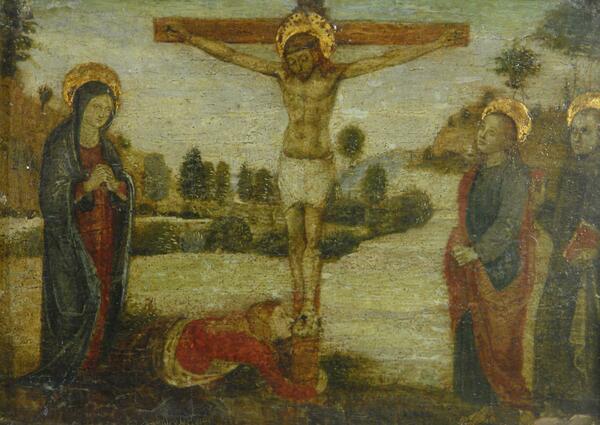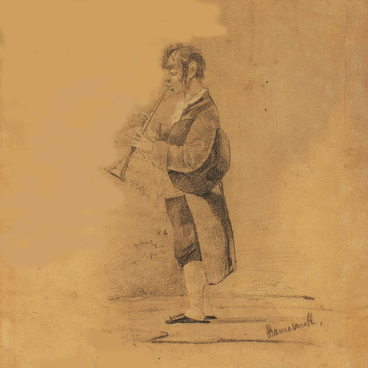“The Crucifixion with the Forthcoming and Saint Francis of Assisi” is one of the pearls of the collection of Nikolai Rakitsky, which laid the foundation for the collection of the Tarusa Art Gallery. It was acquired by Rakitsky in the 1920s on the recommendation of the restorer of the State Hermitage and the Russian Museum Dmitry Bogoslovsky. The image refers to the end of the Early Renaissance, the 15th century, and is filled with egg tempera on a poplar tree. The exact authorship of the artist has not been determined, but he was from the circle of Niccolò Alunno (circa 1430–1502) and belonged to the Umbrian school.
Tuscan artists played an important role in its formation. They taught masters from Umbria in Florence, and some came to fulfill orders for painting churches themselves. The center of the Umbrian school of painting was the city of Perugia. Piero della Francesca belonged to this school, later Rafael Santi became its descendant, and influenced the development of the Roman school.
The crucifixion was part of the altar predella — the foot of the altar image. It had the shape of a long narrow board on which scenes from hagiography were reproduced. This explains the small size of the Crucifixion. In the center of the image is the crucified Christ with a crown of thorns on his head. His body is carefully and realistically painted. At the foot of the cross is depicted the sprawled figure of Mary Magdalene kissing the feet of the Savior. Behind her, a little further off, stands the praying Mother of God. On the other side of Christ is depicted the young John the Theologian, and next to him is St. Francis of Assisi. Its inclusion in the composition is not accidental: Assisi is a city in Umbria, from which the saint came from and where he founded his first monastery of the Franciscan order.
The artist used pale shades of blue and green to paint the landscape, purple and blue to paint his clothes. The nimbus of the saints is covered with gold. Smooth lines, a reflection of the poetic harmony of man and nature, a gentle landscape full of air, pastel colors are features characteristic of the Umbrian school. The artistic language of drawing and reproducing images — giving them realism, the features of the faces evoke associations with the works of the master of the same period, Niccolò Alunno.
The color of the work is almost monochrome, but many shades create color richness. Basically, the artist used bluish and greenish tones for painting landscapes, whites, browns, blues and reddish for writing robes. A landscape with pale blue skies and delicate fresh greenery reveals the results of the persistent artistic quest that distinguished Italian painting of the late 15th century. The artistic structure of the work definitely brings it closer to the works made in Umbria during the last decades of the 15th century, and the stylistic features resemble those of the master Niccolò Alunno.
Tuscan artists played an important role in its formation. They taught masters from Umbria in Florence, and some came to fulfill orders for painting churches themselves. The center of the Umbrian school of painting was the city of Perugia. Piero della Francesca belonged to this school, later Rafael Santi became its descendant, and influenced the development of the Roman school.
The crucifixion was part of the altar predella — the foot of the altar image. It had the shape of a long narrow board on which scenes from hagiography were reproduced. This explains the small size of the Crucifixion. In the center of the image is the crucified Christ with a crown of thorns on his head. His body is carefully and realistically painted. At the foot of the cross is depicted the sprawled figure of Mary Magdalene kissing the feet of the Savior. Behind her, a little further off, stands the praying Mother of God. On the other side of Christ is depicted the young John the Theologian, and next to him is St. Francis of Assisi. Its inclusion in the composition is not accidental: Assisi is a city in Umbria, from which the saint came from and where he founded his first monastery of the Franciscan order.
The artist used pale shades of blue and green to paint the landscape, purple and blue to paint his clothes. The nimbus of the saints is covered with gold. Smooth lines, a reflection of the poetic harmony of man and nature, a gentle landscape full of air, pastel colors are features characteristic of the Umbrian school. The artistic language of drawing and reproducing images — giving them realism, the features of the faces evoke associations with the works of the master of the same period, Niccolò Alunno.
The color of the work is almost monochrome, but many shades create color richness. Basically, the artist used bluish and greenish tones for painting landscapes, whites, browns, blues and reddish for writing robes. A landscape with pale blue skies and delicate fresh greenery reveals the results of the persistent artistic quest that distinguished Italian painting of the late 15th century. The artistic structure of the work definitely brings it closer to the works made in Umbria during the last decades of the 15th century, and the stylistic features resemble those of the master Niccolò Alunno.



